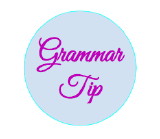7.2: Types of sentences
- Page ID
- 36315
Type of Sentences and Coordinating Conjunctions

Sentence Patterns
Most English sentences, no matter how long or complicated, make use of the following five basic sentence patterns:
PATTERN 1: SUBJECT + VERB
Example: The hammer fell.
The verb, "fell," in this type of sentence is intransitive, meaning that it does not require a direct object, as the transitive verbs do in Patterns 4 and 5. Also, not being a linking verb (see Patterns 2 and 3), it does not require a complement. It is possible, then, for a sentence using this pattern to be comprised of only a subject and a verb, as in this example. However, modifiers can always be added, making the sentence longer.
Consider this example: The hammer fell with great force. In this example "with great force" is a prepositional phrase added to describe (or modify) how the hammer fell. But, because this prepositional phrase is extra material that is not essential to the sentence's structure (the sentence is grammatically complete without it), this longer version is still an example of the basic Subject + Verb sentence pattern.
PATTERN 2: SUBJECT + LINKING VERB + NOUN
Example: The professor is an economist.
This pattern is distinguished by its use of a linking verb. The most common linking verb in English is "to be," which is conjugated as is in this example. In this pattern, the linking verb is used to rename the subject by linking it to another noun, as in this example where the professor is said to be an economist. This renaming noun is known as the complement of the linking verb.
PATTERN 3: SUBJECT + LINKING VERB + ADJECTIVE
Example: The athlete is tall.
As in Pattern 2, this pattern uses a linking verb "is" (to be) to connect the subject with a complement, but here the complement is an adjective, "tall," that describes the subject.
PATTERN 4: SUBJECT + VERB + DIRECT OBJECT
Example: The pitcher threw the ball.
The verb in this pattern is transitive: it requires that the action be performed on something or someone. In other words, something or someone receives the action of the verb (threw, in this example), and that thing or person is the direct object (the ball, in this example).
PATTERN 5: SUBJECT + VERB + INDIRECT OBJECT + DIRECT OBJECT
Example: The lobbyists gave the Congressmen money.
In this pattern, the transitive verb takes both a direct object and an indirect object. In this example, the direct object is "money" (because money is the thing that was given) and the indirect object is "Congressmen."
The indirect object identifies to whom (or which) or for whom (or which) the action is done. The indirect object is usually a noun or pronoun, and in this pattern it comes before the direct object. Usually a sentence using this pattern can be re-written in a form that places the indirect object in a prepositional phrase that comes after the direct object, thus: The lobbyists gave money to the Congressmen. Here the indirect object, the Congressmen, becomes the object of the preposition to.
Compound Sentences: Joining Clauses with Coordination
A compound sentence consists of two independent clauses joined by coordination. Coordination connects the two clauses in a way that emphasizes both clauses equally. Consider these two sentences:
|
Original sentences:
In their current form, these sentences contain two separate ideas that may or may not be related. Am I staying home this week because I spent my paycheck, or is there another reason for my lack of enthusiasm to leave the house? |
Revised Sentence:
The revised sentence, utilizing the coordinating conjunction "so," illustrates that the two ideas are connected. Notice that the sentence retains two independent clauses (I spent my entire paycheck; I am staying home this weekend) because each can stand alone as a complete idea. |
Coordinating Conjunctions
A coordinating conjunction is a word that joins two independent clauses. The most common coordinating conjunctions are for, and, nor, but, or, yet, and so. Note that a comma precedes the coordinating conjunction when it joins two independent clauses.
Table of Coordinating Conjunctions
| Independent Clause | Coordinating Conjunction | Independent Clause | Revised Sentence |
|---|---|---|---|
| I will not be attending the dance. | for (indicates a reason or cause) | I have no one to go with. | I will not be attending the dance, for I have no one to go with. |
| Posters announcing the dance are everywhere. | and (joins two ideas) | Teachers have talked about it in class. | Posters announcing the dance are everywhere, and teachers have talked about it in class. |
| Jessie isn't going to be at the dance. | nor (indicates a negative) | Tom won't be there either. | Jessie isn't going to be at the dance, nor will Tom be there. |
| The fundraisers are hoping for a record-breaking attendance. | but, yet (both words indicate a contrast; but is more commonly used) | I don't think many people are going. | The fundraisers are hoping for a record-breaking attendance, but don't think many people are going. |
| I might go to the next fundraising event. | or (offers an alternative) | I might donate some money to the cause. | I might go to the next fundraising event, or I might donate some money to the cause. |
| Buying a new dress is expensive. | so (indicates a result) | By staying home I will save money. | Buying a new dress is expensive, so by staying home I will save money. |
 To help you remember the seven coordinating conjunctions, think of the acronym FANBOYS: For, And, Nor, But, Or, Yet, So.
To help you remember the seven coordinating conjunctions, think of the acronym FANBOYS: For, And, Nor, But, Or, Yet, So.
Remember that when you use a coordinating conjunction to connect independent clauses, a comma should precede the conjunction. (Exception: the comma is sometimes left out when the clauses are short and closely related. Example: John drove and I gave directions.)
Conjunctive Adverbs
Another method of joining two independent clauses with related and equal ideas is to use a conjunctive adverb and a semicolon. Like coordinating conjunctions, conjunctive adverbs can join independent clauses and indicate a particular relationship between them, but conjunctive adverbs create a stronger break between the clauses than coordinating conjunction do.
Read the following sentences:
|
Original Sentences Bridget wants to take part in the next Olympics. She trains every day. |
Revised Sentence Bridget wants to take part in the next Olympics; therefore, she trains every day. |
Since these sentences contain two equal and related ideas, they may be joined using a conjunctive adverb. Notice that the conjunctive adverb comes after a semicolon that separates the two clauses and is followed by a comma.
Table of Conjunctive Adverbs
| Function | Conjunctive Adverb | Example |
|---|---|---|
| Additional | also, furthermore, moreover, besides | Alicia was late for class and stuck in traffic; furthermore, her shoe heel had broken and she had forgotten her lunch. |
| Comparison | similarly, likewise | Recycling aluminum cans is beneficial to the environment; similarly, reusing plastic bags and switching off lights reduces waste. |
| Contrast | instead, however, conversely | Most people do not walk to work; instead, they drive or take the train. |
| Emphasis | namely, certainly, indeed | The Siberian tiger is a rare creature; namely, there are fewer than five hundred left in the wild. |
| Cause and Effect | accordingly, consequently, hence, thus | I missed my train this morning; consequently, I was late for my meeting. |
| Time | finally, next, subsequently, then | Tim crossed the barrier, jumped over the wall, and pushed through the hole in the fence; finally, he made it to the station. |
Exercise: Combining Sentences with a Coordinating Conjunction or a Conjunctive Adverb

Combining Sentences
Combine each sentence pair into a single sentence using either a coordinating conjunction or a conjunctive adverb:
- Pets are not allowed in Mr. Taylor's building. He owns several cats and a parrot.
- Texting and driving has caused countless car accidents. The state legislature recently outlawed cell phone use while driving.
- Chinua won the local spelling bee. He is going on to the district contest.
- Amphibians are vertebrates that live on land and in the water. Flatworms are invertebrates that live only in water.
- Ashley carefully fed and watered her tomato plants all summer. The tomatoes grew juicy and ripe.
- When he lost his car keys, Simon attempted to open the door with a wire hanger, a credit card, and a paperclip. He called the manufacturer for advice.
Joining Clauses with Subordination

Subordination joins two sentences with related ideas by combining them into an independent clause (a complete sentence) and a dependent clause (a construction that relies on the independent clause, also called the main clause, to complete its meaning). While coordination allows a writer to give equal weight to the two ideas that are being combined, subordination enables a writer to emphasize one idea over the other. Take a look at the following sentences:
|
Original Sentences Tracy stopped to help the injured man. She would be late for work. |
Revised Sentence Even though Tracy would be late for work, she stopped to help the injured man. |
To illustrate that these two ideas are related, we can rewrite them as a single sentence using the subordinating conjunction, "even though."
In the revised version, we now have an independent clause, "she stopped to help the injured man," that stands as a complete sentence, and a dependent clause, "even though Tracy would be late for work," that is subordinate to the main clause.
Notice that the revised sentence emphasizes the fact that Tracy stopped to help the injured man, rather than the fact that she would be late for work. We could also write the sentence this way:
Tracy stopped to help the injured man even though she would be late for work.
The meaning remains the same in both sentences, with the subordinating conjunction, "even though," introducing the dependent clause.
 To punctuate sentences correctly, look at the position of the main clause and the subordinate clause. If a subordinate clause precedes the main clause, use a comma. If the subordinate clause follows the main clause, no punctuation is required.
To punctuate sentences correctly, look at the position of the main clause and the subordinate clause. If a subordinate clause precedes the main clause, use a comma. If the subordinate clause follows the main clause, no punctuation is required.
Exception: subordinate clauses that begin with conjunctions that indicate concession (see table below) are sometimes preceded by a comma, even when they follow the main clause.
Subordinating Conjunctions and Adverb Clauses
A subordinating conjunction is a word that joins a subordinate (dependent) clause to a main (independent) clause. Since the resulting subordinate clause modifies the verb in the main clause, the subordinate unit is called an adverb clause.
Subordinating Conjunctions Table
| Function | Subordinating Conjunction | Example |
|---|---|---|
| Concession | although, while, though, whereas, even though | Sarah completed her report even though she had to stay late to get it done. |
| Condition | if, unless, until | Until we know what is causing the problem, we will not be able to fix it. |
| Manner (used to make a comparison) | as if, as though | The students in the conference room stopped talking at once, as though they had been stunned into silence. |
| Place | where, wherever | Where the trail split, our guide stopped, unsure of which route to take. |
| Reason | because, since, so that, in order that | Because the air conditioning was turned up so high, everyone in the office wore sweaters. |
| Time | after, before, while, once, when, as, as soon as | After the meeting had finished, we all went to lunch. |
Exercise: Combining Sentences Using Subordinating Conjunctions

Combine each sentence pair into a single sentence using a subordinating conjunction:
- A snow storm disrupted traffic all over the east coast. There will be long delivery delays this week.
- My neighbor had his television volume turned up too high. I banged on his door and asked him to keep the noise down.
- Jessica prepared the potato salad and the sauteed vegetables. Ashley marinated the chicken.
- Romeo poisons himself. Juliet awakes to find Romeo dead and stabs herself with a dagger.
Relative Pronouns and Adjective Clauses

While an adverb clause modifies the verb in an independent clause, an adjective clause modifies a noun. The modified noun may function in the sentence in any number of ways. It may be a subject, complement, direct object, or the object of a preposition.
Consider the following:
|
Original Sentences Jill and her friends camped near a silver mine. The mine had been abandoned for fifty years. |
Combined Sentence Jill and her friends camped near a silver mine that had been abandoned for fifty years. |
The second sentence modifies or tells about the silver mine, which is the object of a preposition (near) in the first sentence. We can turn the second sentence into a subordinate adjective clause and attach it to the first sentence.
The adjective clause is emphasized in pink. The adjective clause replaces the original subject of the second sentence (The mine) to form a subordinate adjective clause, and the clause is then attached to the first sentence, which becomes the main clause.
The relative pronoun in this example is "that." Like subordinating conjunctions, relative pronouns are used to make a clause dependent (or subordinate). Unlike subordinating conjunctions, relative pronouns take the place of another word, just as other pronouns do.
Unlike adverb clauses, which can be located either before or after a main clause, an adjective clause must be located immediately after the noun that it modifies. If this rule is not followed, the adjective clause becomes a misplaced modifier (see Parallelism).
The following words can all function as relative pronouns: who, whom, whose, which, that, when, where.
Restrictive and Nonrestrictive Adjective Clauses
An adjective clause is restrictive if it is essential for identifying (restricting) the noun that it modifies. A nonrestrictive clause may be important to the sentence, but it is not essential for identifying the noun. This distinction is important because nonrestrictive clauses must be set off from the main clause with commas.
Consider these examples:
|
Nonrestrictive Clause My brother Frank, who ran cross country in high school, beat everybody in the foot race. |
Restrictive Clause A young man who ran cross country in high school beat everybody in the foot race. |
Both these sentences contain the same adjective clause, "who ran cross country in high school," but in the first example the clause modifies a subject identified with a proper noun "Frank" and the designation "my brother." Consequently, the adjective clause is not necessary to the identification of the subject. It is nonrestrictive and set off with two commas, one before the clause and one after it.
In the second example, the subject is simply “A young man.” Consequently, the adjective clause is necessary to the identification of who this particular young man is. The clause is restrictive and is not set off with commas (see comma use).
The table below illustrates relative pronouns and how they function to create adjective clauses.
Table of Relative Pronouns
| Function of Relative Pronoun | Relative Pronoun | Example (with adjective clause highlighted) |
|---|---|---|
| Takes the place of a noun referring to people. | who | My roommate, who is from Brazil, is majoring in physics. |
| Takes the place of a direct object referring to people. |
whom Note: "Whom" is generally used only in formal writing. "Who" is often used in its place in colloquial English. When "whom" is used in a restrictive clause, it may be deleted from the sentence. Example: The band leader hired a musician he had known in Ogden to play the harmonica. |
The band hired Slim Swayze, whom the lead singer had known in Ogden, to play the harmonica. |
| Takes the place of a noun referring to things. Generally used in nonrestrictive clauses. | which | The Old Man and the Sea, which I read last year, tells the story of a fisherman in the Gulf of Mexico. |
| Takes the place of a noun referring to people or things. Used only in restrictive clauses. |
that Note: When that is used to replace a direct object, it may be deleted from the sentence. Example: The tacos I ate were delicious. |
The tourist blundered down a street that seemed to lead nowhere. |
| Creates a clause that modifies a particular time. | when | Audrey and I recalled the time when we played together on the volleyball team. |
| Creates a clause that modifies a particular place. | where | Joe spent spring break in North Carolina, where his cousins live. |
| Indicates a condition of ownership between the modified noun and the subject of the adjective clause. | whose | An elderly woman whose car had been stolen sat on a bench in the police station. |
Exercise: Combining Sentences with Coordination and Subordination

Use coordination and/or subordination to combine each set of simple sentences into a single sentence.
- Heroin is an extremely addictive drug. Thousands of heroin addicts die each year.
- Shakespeare’s writing is still relevant today. He wrote about timeless themes. These themes include love, hate, jealousy, death, and destiny.
- Gay marriage was first legal in the U.S in the six states of Iowa, Massachusetts, Connecticut, Vermont, New Hampshire, and Maine. Other states followed their example.
- Prewriting is a vital stage of the writing process. Prewriting helps you organize your ideas. Types of prewriting include outlining, brainstorming, and idea mapping.
- Mitch drank a strange potion. It transformed him into a cat. He ate an entire bag of cat food. His cat watched him hungrily.
KEY TAKEAWAYS
- Coordination and subordination join two sentences with related ideas. Coordination joins sentences with related and equal ideas, whereas subordination joins sentences with related but unequal ideas.
- Sentences can be coordinated using either a coordinating conjunction and a comma or a conjunctive adverb and a semicolon.
- Subordinate adverb clauses are made by the use of a subordinating conjunction.
- In a sentence with an adverb clause, a comma is generally used to separate the main clause from the dependent clause if the dependent clause is placed at the beginning of the sentence.

